|
from Tschigorin's column in Novoe
Vremya May 21 (June 3rd), 1901
The following interesting game was played recently in Kiev.
Michael Sicard - Prince Dadian of
Mingrelia
The quotes (from the Field by Hoffer)
are English translations from the original Russian
1. e4 e5 2. d4 exd4 3. Qxd4 Nc6 4. Qe3 g6 5. Bd2 Bg7 6. Nc3 Nf6
7. Be2 O-O 8. O-O-O d5 9. exd5 Nxd5 10. Nxd5 Qxd5 11. Kb1
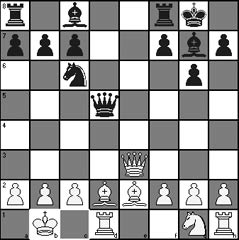
Hoffer points out [in The Field] that better,
apparently, is the continuation: 11. c4! Qd4 12. Qxd4 Nxd4 13. Bc3 Nxe2+
14. Nxe2 with an equal game. However, by playing 13... c5! (in the place
of 13. ...Nxe2?) Black would have had an obvious superiority of position.
...Be6 12. b3
"Still now" say Mr. Hoffer, "12. c4 was better, than
the move made in the game, weakening the pawn". Why is b3, but not c4,
somehow weakening? Mr. Sicard probably foresaw after 13. c4 Qd4 14. Qxd4
Nxd4 15. Bc3 Nxe2 losing the pawn on c4. Therefore he chose the obvious
lesser of the two evils.)
...Bd4 13. Qg3 Qc5 14. f4
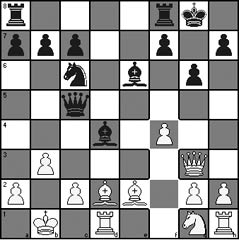
"White", the commentator advises, "ought to seek the opportunity to
exchange his pieces with those which his opponent is executing his
attack", and suggests playing 14. Be3 Nb4 15. Bd3 on the basis that Black
cannot take the pawn at a2 with the Knight in view of 16. Bxd4. The idea,
however, falls in with the opponent's wishes, Black playing 15. ...Bxe3
16. Qxe3 Qa5 17. a4 Nd5 winning at least the exchange. If 18. Qd2 Nc3+
19. Kc1 then 19. ...Qb4)
...Qb6
in order to threaten ...Bxb3 to hinder White from
playing c3.
15. Nf3 Bg7 16. Bd3 a5 17. Rde1
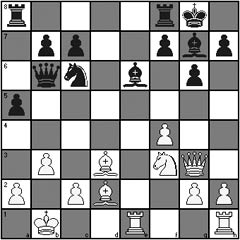
"Now [I would consider already from move 10] White's
position is very difficult", observes the impartial commentator, "If 17.
f5 a4 18. fxe6, then axb3 19. cxb3 Rxa2!, and Black wins. Or 17. Ne5 a4
18. Bc4 Nxe5 19. Bxe6 Nc6 20. Bc4 axb3 21. Q(or B)xb3 Rxa2! and Black
wins"
...a4 18. Be3 axb3
Finally there appears the occasion for a brilliant
combination which Black foresaw when he played ...a4" (Hoffer). With the
move 18. ...axb3 Black undoubtedly wins, if 19. cxb3 (19. Bxb6 bxa2+
etc.) is met by 19. ...Qa5! followed by 20. ...Qc3 which compels
the opponent to immediately capitulate. But if one has "beauty" in mind,
then it would follow to play 18. ...Qb4 also, provoking 19. Bd2 Qa3 20.
Qc1 giving mate in 3 moves. With such an ending the game would have been
unquestionably very good.
19. cxb3 Qxb3+
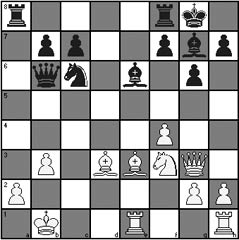
! or ?.
"Beautifully and correctly played. Black forces the
win.", says Hoffer. But with 19. ...Qa5!, followed by ...Qc3 would
quickly and surely decide the victory.
20. axb3 Ra1+ 21. Kc2 Nb4+ 22. Kd2 Ra2+ 23. Bc2 Rxc2+ 24. Kd1 Bxb3 25.
Nd2 Rd8 26. Ke2 Bc3 27. Kf3
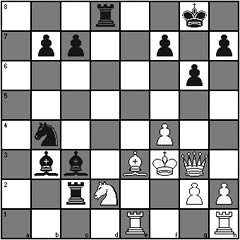
If 27. Kf1 the 27. ...Bxd2 28. Bxd2 Bc4+ 29. Kg1 Rxd2
and Black wins.
...Bxd2 28. Bxd2 Rcxd2
The Bishop should have been taken by the Rook on d8.
If 29. Ke4, then 29. ...Bd5+ 30. Ke5 Kg7 etc.
29. Kg4 Be6+ 30. Kh4?
"Better was 30. Rxe6, but in that case", adds Mr.
Hoffer, "Black wins in the following manner: 30. Rxe6 fxe6 31. Qb3 Rxg2+
32. Kf3 Rd3+ 33. Qxd3 Nxd3 34. Kxg2 Nxf4+ etc.". For White however it is
not obligatory to move the Queen to b3, but after it he loses. After 30.
Rxe6! fxe6 31. Qb3 Rxg2+ every player would naturally have played 32.
Kh4.
...R2d3 31. Re3 R8d5 32. Qf3 g5+ 33. fxg5 R5d4+
34. Kh5 Bg4+ 35. Qxg4 Rxg4
36. Rxd3 Nxd3 37. Kxg4 Nf2+
white resigns
return
|

